The Esoteric SA-50 SACD Player
| The Esoteric SA-50 SACD Player |
| Don’t Be Tardy For The party! |
|
|
|
April 2011 |
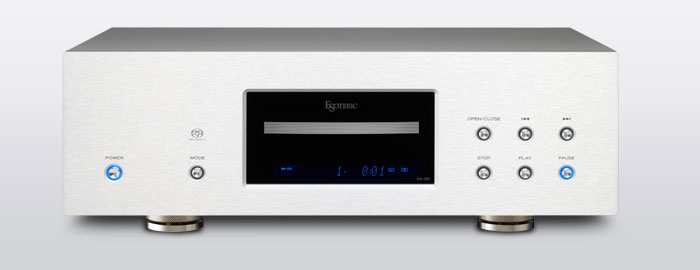
I have to admit to being one of those people who sometimes doesn’t pick up on new innovations until those innovations become… well, not so new anymore. I bought my first CD player about the same time that Napster began changing the way we bought music. I set up a MySpace account while everyone else I knew was going with this thing called Facebook, and I bought my first HDCD disc at about the same time that Sony introduced their legendary SCD-1 SACD player. Now the good people at Esoteric have allowed me to spend some time with their SA-50 CD/SACD Player and wouldn’t you know it, a reporter from CNET proclaims the “death of the compact disc,” during a report from the 2011 Consumer Electronics Show. So once again, it seems as though your ol’ buddy Dave is a little, “tardy for the party” as my friends like to say. But thanks to companies like Mobile Fidelity and Analogue Productions there is a rather healthy library of wonderful SACD discs available. So if you’re still inclined to make this format a staple in your music system (and you should), boy, do I have a great one to tell you about.
About the SA-50
Esoteric has rolled out some pretty stellar products over the years and recently have introduced state-of-the-art loudspeakers and amplification products. But make no mistake it has been their array of innovative digital products that have clearly set them apart and among the elite of high-end audio component companies. The $5,800.00 Esoteric SA-50 CD/SACD Player is a classic example of what makes this company so great.
The SA-50 may immediately be thought of as a disc player, but after spending some time with it, I’m more inclined to call it a digital preamp/32-bit DAC with a built-in transport. Frankly, this unit could easily be a standalone device in any of these regards. In other words, it can truly be used as a digital preamp which will allow you to choose from four digital sources: CD/SACD playback of course, but there’s also an optical input (243-bit/192kHz), an S/PDIF input (24-bit/192kHz), and a USB input (16-bit/48kHz). It also has a digital volume attenuator, meaning it can be run straight to your amp. I actually did much of my listening to this unit with it connected directly into the digital amplifier of the Behold Gentle and the Soaring Audio SLC-A300 amplifiers (More on that in a bit. No pun intended).
But the SA-50 can also be used as a 32-bit dual mono (one chip per channel) digital-to-analog converter. It is capable of playing most compressed and uncompressed music formats including WAV, lossless, AIFF, MP3, and FLAC. This means the SA-50 can also be an integral part of a PC or Mac-based system.
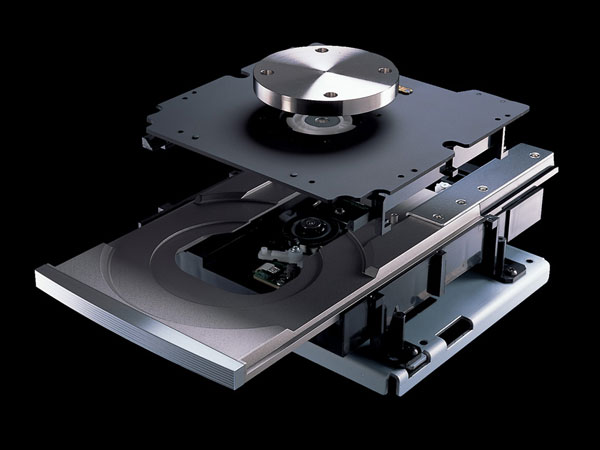
Finally, the SA-50’s digital outputs allow it to be used as a standalone transport. It features the Vertically-aligned Optical Stability Platform (VOSP) disc drive mechanism. This drive unit features a proprietary shaft-mounted laser pickup assembly whose lineage is derived from the legendary P-01 and P-03, both of which costs far more than the SA-50. The VOSP is clamped by a steel plate and a large diameter stabilizer made of 8mm thick steel, greatly reducing vibration from the spinning disc. It is then mounted on the bottom chassis and to two internal steel brackets for ultimate rigidity.
Aesthetically, the SA-50 eschews some of the beautifully sculpted lines of some of its pricier siblings such as the K-01 ($22,000) and K-03 ($13,000) but is still very elegant looking with its simple, clean, straight lines and recessed buttons. The brushed aluminum front panel features a recessed black acrylic display with a cobalt blue LED readout near the bottom and the drive mechanism’s disc drawer above it. The LED display was fairly easy for me to read from as far as 20’ away which is always indicative of a well made component. To the right of the display are two rows of three buttons which perform the basic operations of the SA-50. To the left is a blue backlit “Power” button and a “Mode” button, which according the owner’s manual is used to select between the following CD playback modes:
ORG (Original): Up conversion is not performed. (With a D/A converter, the digital filter performs 32-bit, 8-times oversampling.)
2Fs: When the digital audio signal from a CD or external input is 32/44.1/48 kHz, the input signal is up converted to 64/88.2/96 kHz.
4Fs: When the digital audio signal from a CD or external input is 32/44.1/48/88.2/96 kHz, the input signal is up converted to 128/176.4/192 kHz.
DSD: The PCM digital audio signal from a CD or external input is converted to a DSD signal. (DSD = Direct Stream Digital)
For SACD playback, these are the available modes:
DSD: The DSD audio signal of Super Audio CDs is not converted and will playback in its native format.
2Fs+6: The DSD audio signal of Super Audio CDs is converted to a 88.2 kHz/32-bit PCM signal. To remove volume differences with standard CDs, the gain is raised by 6 dB.
4Fs+6: The DSD audio signal of Super Audio CDs is converted to a176.4 kHz/32-bit PCM signal. To remove volume differences with standard CDs, the gain is raised by 6 dB.
2Fs: The DSD audio signal of Super Audio CDs is converted to a88.2 kHz/32-bit PCM signal. The volume difference with standard CDs is approximately 6 dB. Adjust the volume of the connected amplifier accordingly.
4Fs: The DSD audio signal of Super Audio CDs is converted to a 176.4 kHz/32-bit PCM signal. The volume difference with standard CDs is approximately 6 dB. Adjust the volume of the connected amplifier accordingly.
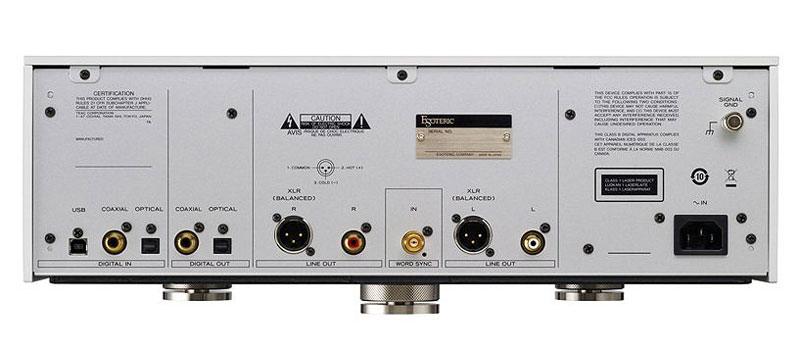
The rear panel is thoughtfully laid out and completely “idiot proofed.” Looking at it from behind, the digital inputs (“USB”, “Coaxial”, and “Optical”) are neatly laid out and easy to read, as are the digital outputs (“Coaxial” and “Optical”), a set of “Balanced” (XLR) and “Unbalanced” (RCA) line outputs, and a “Word Sync” input. And finally, a “Signal Ground” (nice touch) and power cord connector round out the rear panel connections. Actually, just studying all these connections for a few minutes tells you just how much flexibility the SA-50 gives you. Frankly, it’s a whole for under $6K and not bad to look at either. The remote control is very well, is intuitive to use, and allows you to control all of the unit’s features from your comfy spot.
Setup
The system used for most of my listening turned out to be one of the most resolved systems I’ve ever had. The SA-50 was connected to an amplifier that offers about as much flexibility and high performance as it does: the Behold Gentle. The Gentle has its own internal DAC and both, digital and analog power amplifiers, and can accept the SA-50’s coaxial and optical outputs. And by using the Gentle’s digital amp, you can play music completely in the digital domain. I was even able to feed my iTunes library from an Apple TV box into the SA-50’s optical input and then into the Gentle. It would take a lot more pages than most people want to read off a computer screen for me to go into all the different configurations that these two pieces will allow, so I’ll try to keep my focus on the SA-50 as a disc player, meaning that I primarily used the SA-50’s unbalanced Line Out into the Gentle’s digital amp. The amp was connected to the excellent Dynaudio Sapphire loudspeakers and the whole system was connected with Entreq Konstantin cables.
Let the Player Play
Operationally, the SA-50 is actually pretty straight forward. So after taking some time to read up on all that the SA-50 has to offer, it was finally time to start listening. 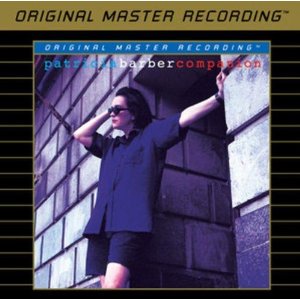 I headed straight for my stack of Mobile Fidelity SACD discs and pulled out Patricia Barber’sCompanion [UDSACD 2023]. Those of you who are already familiar with this disc know that it is a wonderful live recording, but rendered in all its super audio glory, it could more aptly have been titled Intimate Companion. The first track, “The Beat Goes On,” engulfs you with the atmosphere of the venue. Barber’s voice is smooth and warm and all of the instruments, particularly Michael Arnopol’s bass sound completely natural and three-dimensional. The same can be said of the second track, Barber’s cover of the Bill Withers classic, “Use Me.” Again, it is the fabulous strumming of the bass that makes this tune stand out, and the SA-50 does a wonderful job of fleshing out the musical textures of the recordings. A much more dynamic tune is the next track, “Like JT.” This song is loaded with great percussions, not to mention Barber’s own splendid piano work. The transients were sharp and airy, and the width and depth of the soundstage was not overblown or flat. It didn’t take long for the SA-50 to prove itself to be something special.
I headed straight for my stack of Mobile Fidelity SACD discs and pulled out Patricia Barber’sCompanion [UDSACD 2023]. Those of you who are already familiar with this disc know that it is a wonderful live recording, but rendered in all its super audio glory, it could more aptly have been titled Intimate Companion. The first track, “The Beat Goes On,” engulfs you with the atmosphere of the venue. Barber’s voice is smooth and warm and all of the instruments, particularly Michael Arnopol’s bass sound completely natural and three-dimensional. The same can be said of the second track, Barber’s cover of the Bill Withers classic, “Use Me.” Again, it is the fabulous strumming of the bass that makes this tune stand out, and the SA-50 does a wonderful job of fleshing out the musical textures of the recordings. A much more dynamic tune is the next track, “Like JT.” This song is loaded with great percussions, not to mention Barber’s own splendid piano work. The transients were sharp and airy, and the width and depth of the soundstage was not overblown or flat. It didn’t take long for the SA-50 to prove itself to be something special.
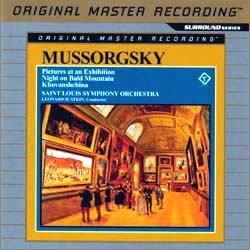 I dove into some classical music with the next recording, Leonard Slatkin and the St. Louis Symphony Orchestra performing Mussorgsky: Pictures At An Exhibition[UDSACD 4004]. Track 16, “Night On Bald Mountain,” is an absolute hoot to listen to (sorry, my mom bet me I couldn’t find a away to use the word “hoot” in an audiophile equipment review). Actually, it was a hoot going from the small intimate live lounge setting of Barber’s Companion to this full blast orchestral piece. The Dynamics of this track were portrayed amazingly well with the SA-50, and as is to be expected, the soundstage was huge, but never did overwhelm my room. The musicians seemed to occupy real space and instruments remained natural sounding. On a lesser player (or lesser recording) mass strings can sometimes sound synthesized. That wasn’t the case here.
I dove into some classical music with the next recording, Leonard Slatkin and the St. Louis Symphony Orchestra performing Mussorgsky: Pictures At An Exhibition[UDSACD 4004]. Track 16, “Night On Bald Mountain,” is an absolute hoot to listen to (sorry, my mom bet me I couldn’t find a away to use the word “hoot” in an audiophile equipment review). Actually, it was a hoot going from the small intimate live lounge setting of Barber’s Companion to this full blast orchestral piece. The Dynamics of this track were portrayed amazingly well with the SA-50, and as is to be expected, the soundstage was huge, but never did overwhelm my room. The musicians seemed to occupy real space and instruments remained natural sounding. On a lesser player (or lesser recording) mass strings can sometimes sound synthesized. That wasn’t the case here.
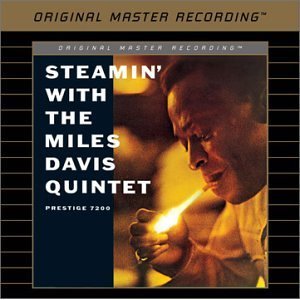 The next disc was the Miles Davis Quintet’s Steamin’[UDSACD 2019]. I first heard this disc back in 2004 and have to admit to not being particularly blown away by it. SACD was still an emerging format and the players available at the time probably just couldn’t draw the best from them; my how things have changed. Track 6, “When I Fall In Love” features a really sweet performance by Davis and the unmistakable support of John Coltrane and pianist Red Garland. Two other tracks, “Salt Peanuts” and “Diane” are rendered nicely by the SA-50. The amount and quality of detail pulled from the recording and the excellent rhythm and pace of the music were extremely tight and focused. The SA-50’s many qualities shine on music like this and fans of snappy dynamics will be completely delighted.
The next disc was the Miles Davis Quintet’s Steamin’[UDSACD 2019]. I first heard this disc back in 2004 and have to admit to not being particularly blown away by it. SACD was still an emerging format and the players available at the time probably just couldn’t draw the best from them; my how things have changed. Track 6, “When I Fall In Love” features a really sweet performance by Davis and the unmistakable support of John Coltrane and pianist Red Garland. Two other tracks, “Salt Peanuts” and “Diane” are rendered nicely by the SA-50. The amount and quality of detail pulled from the recording and the excellent rhythm and pace of the music were extremely tight and focused. The SA-50’s many qualities shine on music like this and fans of snappy dynamics will be completely delighted.
But redbook CDs also performed exceptionally well on this player. Jazz pianist Bob Thompson’s The Magic In your Heart [Ichiban ICH1165-2] is a prime example. If you’re not familiar with this splendid musician, I urge you to run to local record store (or iTunes) and seek him out. This disc features a really tight rhythm section paced by Thompson’s nimble finger work as displayed on track 4, “Mi Hermana,” and 5, “A Time for Love.” Thompson can create a layered and bass deep ballad like no one else, and on this disc, the SA-50 renders his performance with such clarity that you’d tend to think that there were two pianists playing instead of one.
Taking a Bite of The Apple
Apple TV is a device that you can use to feed your iTunes library of music and movies into your audio/video system. It comes with an optical audio output which I used to feed the SA-50’s optical input. The results were a revelation. Suddenly, I had my entire iTunes library of music benefitting from being run through the SA-50’s 32-bit DACs. The first thing I listened to was Andreas Vollenweider’s Book of Roses. I have heard this downloaded album a hundred times through my iPod the last couple of years but hearing it for the first time through the SA-50 really floored me. If you’re familiar with this artist (if you’re not you should be) you know that he weaves the textures of classical, jazz, and rock into some of the most compelling and enjoyable music made. Forget the “New Age” tag that he is often slapped with, he’s a brilliant musician and composer. But he also loves to infuse his music with odd little percussive touches. The most prevalent one from this recording (which he separates into four “chapters”) is the crisp sound of a turning page; it comes at the beginning of each chapter and at the end of the final chapter. Another neat touch is on track 7, “Passage to Promise,” which features the vocals of Ladysmith Black Mambazo. At the end of this delightful song Vollenweider uses the sound of dropping pebbles into a bowl as a percussion instrument. The SA-50 recreates this effect nicely and it sounded absolutely cool coming out of the Dynaudio Sapphires. But more importantly, the music comes through with its natural character intact and is eminently enjoyable.
Conclusion
It should be obvious that I was really mesmerized (or I guess you could even say intimidated) by this player and its entire myriad of digital options. I know I didn’t even scratch the surface of what this solidly built, elegant, and thoughtfully designed unit has to offer. But it was enough for me just to be able to take my music listening enjoyment to new heights, just based on its performance as an SACD player.
By now it should be known that I recognized the Esoteric SA-50 as one of 2010’s “Most Wanted Components,’ and now you know why. Yes, my music download library is quickly outgrowing the number of CD/SACD discs that I own, but a unit like the SA-50 now makes it possible to enjoy both worlds, and at a relatively affordable price. Bravo to the folks at Esoteric for producing such a magnificent component. It will allow you to party with it for many years to come and you won’t have to worry about being tardy. Highly recommended!
![]()
Specifications
Disc formats: CD, SACD, CD-R/CD-RW
Analog outputs: Unbalanced (RCA), Balanced (XLR)
Digital inputs: USB (“B” type connector), Coaxial, TosLink
Digital outputs: Coaxial, TosLink
Word Clock Input: TTL levels, 75 ohm, BNC jack (can lock to 44.1kHz, 48kHz, 88.2kHz, 176.4kHz, 100kHz)
Dimensions: 17 3/8” x 6” x 13 7/8” (WxHxD)
Weight: 39.6 lbs.
Price: $5,800.00
Address:
Esoteric Division
TEAC Reference Series
7733 Telegraph Rd.
Montebello, CA. 90640
323-726-0303
Telephone: 323-726-0303
Fax: 323-727-7650
www.esoteric.com
www.teac.com
![]()
Don’t forget to bookmark us! (CTRL-SHFT-D)
Stereo Times Masthead
Publisher/Founder
Clement Perry
Editor
Dave Thomas
Senior Editors
Frank Alles, Mike Girardi, Russell Lichter, Terry London, Moreno Mitchell, Paul Szabady, Bill Wells, Mike Wright, and Stephen Yan,
Current Contributors
David Abramson, Tim Barrall, Dave Allison, Ron Cook, Lewis Dardick, John Hoffman, Dan Secula, Don Shaulis, Greg Simmons, Eric Teh, Greg Voth, Richard Willie, Ed Van Winkle, Rob Dockery, Richard Doran, and Daveed Turek
Site Management Clement Perry
Ad Designer: Martin Perry





Be the first to comment on: The Esoteric SA-50 SACD Player